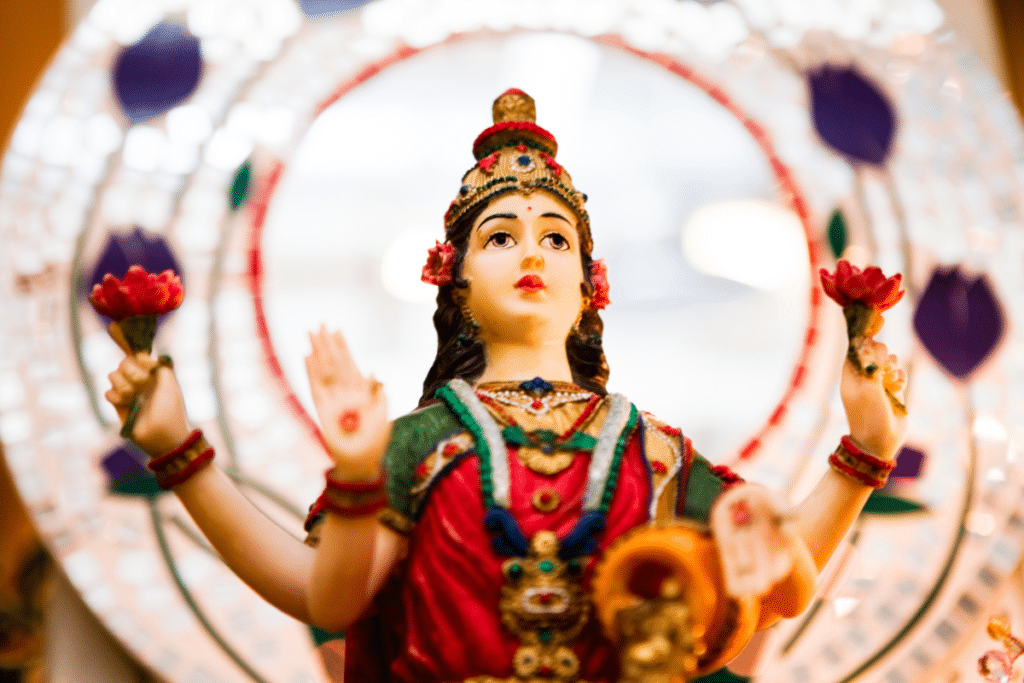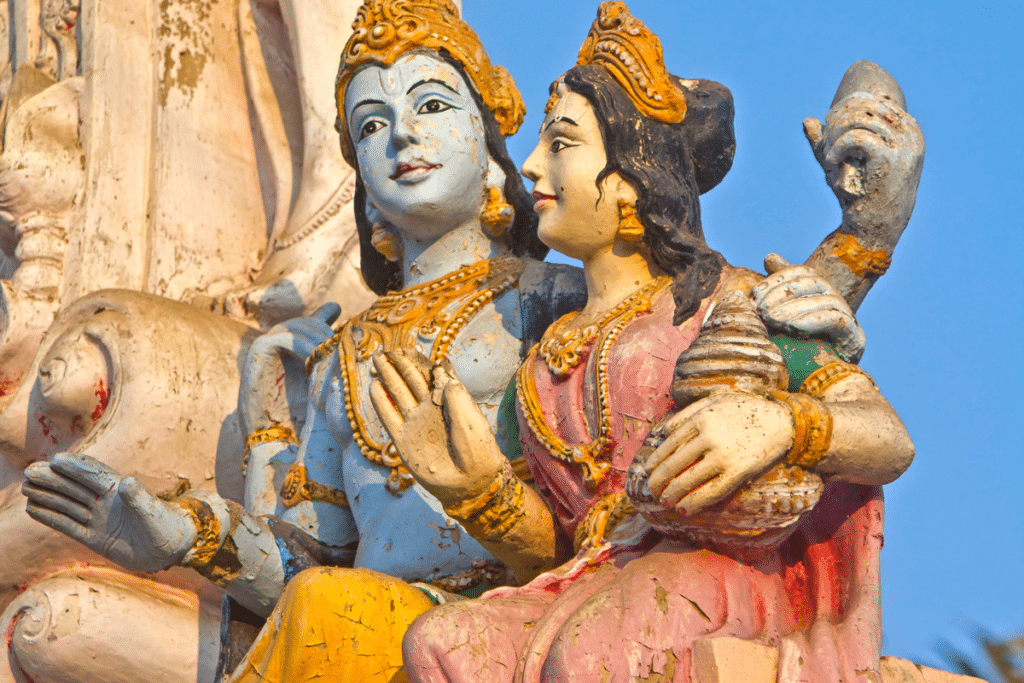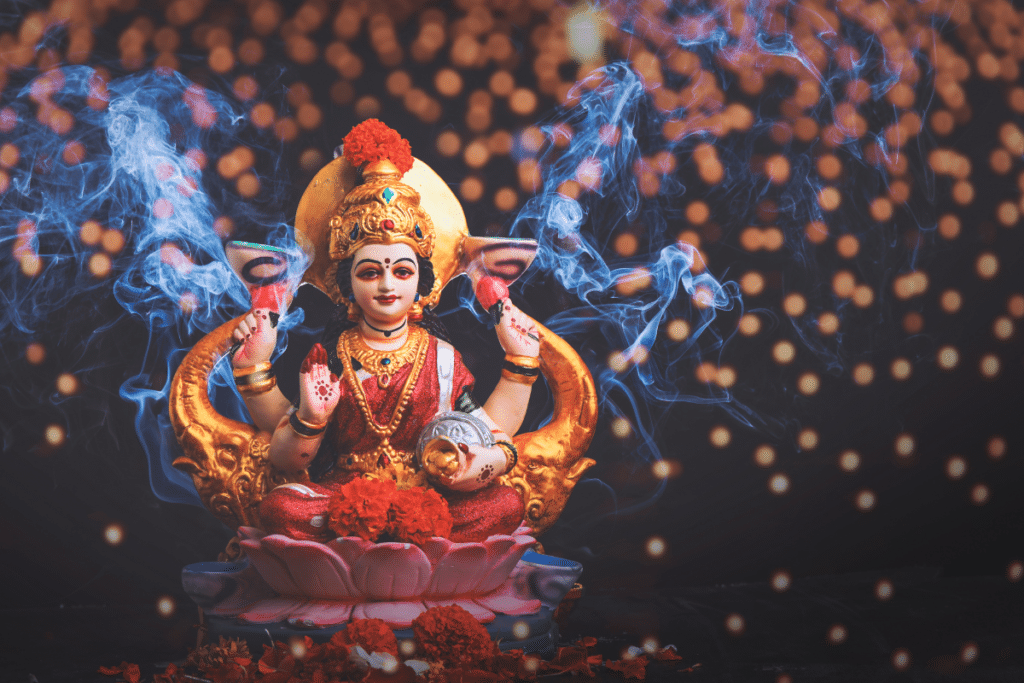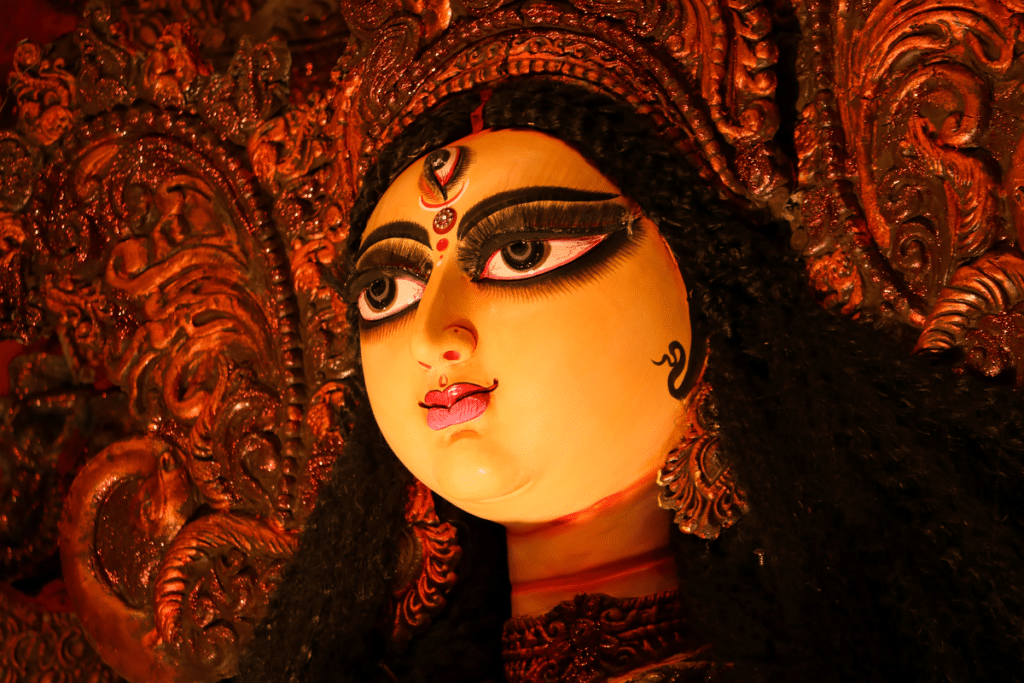Goddess Lakshmi: 3 Invocations for Abundance and Prosperity

Goddess Lakshmi is known as the Goddess of abundance, fortune, and prosperity, both in the material and spiritual realms. The name Lakshmi is derived from the Sanskrit words laks and laksa and means ‘understand your goal.’ It is also related to the word laksana, meaning ‘auspicious opportunity.’
An incarnation of Goddess Shakti, Lakshmi was first mentioned in the Sri Suktam, a devotional hymn found in the sacred Hindu text, the Rigveda. The Sri Suktam describes Goddess Lakshmi as auspicious and regal, lustrous like gold, and radiant like fire. The sacred hymn also states that Lakshmi is the bestower of fame and abundance. Fertility is included in her gifts because it symbolizes the abundant harvest.
Lakshmi and Vishnu
Goddess Lakshmi is the consort of Lord Vishnu. Vishnu is the second god in the Trimurti – the trio of deities who create, maintain, and destroy the world. Brahma is the creator, Vishnu is the maintainer, and Shiva the destroyer. Lakshmi provides the female Shakti energy that Vishnu needs for his purpose.
Lord Vishnu and Goddess Lakshmi are often shown in paintings and sculptures together, reclining on a coiled serpent with Lakshmi massaging Vishnu’s feet.

Depictions of Goddess Lakshmi
Goddess Lakshmi is often depicted as a beautiful female deity with four arms standing or sitting on a giant lotus flower that is floating in water. There are usually one or two elephants anointing her with the sacred water. Sometimes, an owl is present too. In many images, Lakshmi holds a jar of gold coins, which she pours out into a golden tray. Sometimes the gold coins appear directly from the center of her palm.
The lotus is a flower that blooms in beautiful magnificence from roots in muddy foundations. It shows that beauty and prosperity can bloom despite being surrounded by seemingly imperfect conditions, and that the conditions which we perceive as dirty or clouded, are in fact the conditions needed for the transformation – of the lotus seed into flower, and of human spiritual evolution. As Zen Master Thich Nhat Hanh says:
“No Mud, No Lotus.”– Thích Nhất Hạnh
The elephant is a symbol of work, strength, fertility, and abundant prosperity. The owl signifies the pursuit of knowledge, even during darkness, and warns us that it’s easy to become blinded by the light of wealth and knowledge.
The gold coins she pours forth signify that the abundance she offers is generous, and that dāna (giving), is an important part of the generosity of giving and receiving abundance. The abundance offered by this Goddess is spiritual as well as material, and in fact, if you cease to practice dāna and remain connected spiritually, Goddess Lakshmi will disappear.
From the strong symbolism shown in images of Goddess Lakshmi, we can see that her message is that we can achieve abundance and prosperity, but we have to be prepared to be strong and active in the pursuit of our goals, keep striving even through the dark times, and refrain from being blinded by greed and power when we attain our desires.

Legend of Goddess Lakshmi
Goddess Lakshmi was the good luck charm who helped the warrior God Indra to protect the world of the devas (Gods) from the asuras (demons). One day, Lakshmi witnessed Indra being arrogant and disrespectful toward a gift-bearing sage. The Goddess was horrified by his behavior and promptly departed the world into the Kshirasagar (Ocean of Milk).
Without Lakshmi’s blessings of good fortune, the world soon became dark and overrun with asuras. The devas lost their power and success and Indra began to despair. He asked Lord Vishnu what could be done about the disaster. Vishnu replied that the devas would need to churn the Kshirasagar to bear Goddess Lakshmi to the surface again.
Lord Vishnu also divulged that there would be other treasures from the churning of the Ocean of Milk, such as amrita (elixir of immortality) that would help them defeat the asuras. The devas knew that they couldn’t churn the ocean by themselves, so they enlisted the help of the asuras by promising to share the amrita.
Together the devas and the asuras churned the Kshirasagar for 1000 years and finally, Lakshmi and the elixir rose to the surface, bestowing all their wonderful gifts. The tale highlights what the symbolism from Lakshmi images show us; that hard work, persistence, and effort will be rewarded with abundance and good fortune.
Festival of Diwali
Goddess Lakshmi is worshipped all year round, but especially during Diwali, the festival of lights. During this five-day celebration, Hindus place lamps in their windows to light Lakshmi’s way to their homes so that she can bless them, their houses, and their families. Many Hindus will start business ventures and strike deals around Diwali so that their endeavors are successful.

Invoking Goddess Lakshmi
It is important to remember that when you invoke Lakshmi you are asking for abundance on all levels – spiritual, physical, and material. Lakshmi does not separate these areas; abundance is abundance, and it will manifest where it is needed most.
You can benefit from the abundance and good fortune of Goddess Lakshmi whenever you wish. Like all Goddesses, there are many ways to connect with her energy and ask for her blessings. The following are three of my personal favorites.
1: Chanting
Chanting is a powerful energy practice that invokes specific vibrational shifts depending on what mantras are being chanted. With mantra chanting, you are retuning your energetic vibration from the inside out, literally retuning your frequency to align with your desires.
With mantra chanting, like most things in life, consistency is key. Although you will most likely feel positive effects after one session, to get results you need to chant daily over a long period of time. The more consistent you are with your daily practice, the better.
Many people still chant the Sri Suktam to invoke Lakshmi’s blessings. The sacred resonance is said to bring the abundance and good fortune synonymous with Goddess Lakshmi. The Sri Suktam is written in Sanskrit but there are some great videos on YouTube that you can chant along with, and most also display the words for you to follow. I like this one.
Another way to invoke Goddess Lakshmi is to chant her mantra:
Om Shreem Mahalakshmiyei Namaha
Chant the Goddess Lakshmi mantra 108 times per session for maximum effect. 108 is an auspicious number in Eastern spirituality. It is the number of spiritual completion, and it represents the wholeness of the universe.
To prepare for a mantra chanting session, get yourself set up like you would for meditation. Ensure that you are sitting comfortably and that you will not be disturbed. If you feel shy about chanting, you might prefer to ensure that you are alone in the house when you first begin your practice, until you get used to it and it feels more natural.
You can play some soft meditation music if you feel it help to get you in the right frame of mind. Take a few long, full, deep breaths to prepare your lungs and ground you. Then, when you feel ready, begin your practice. You can chant alone or along to a recording or video if you prefer. Beginners might find this guidance easier so that they can relax and melt into the practice.
2: Visualization
Visualization is such a powerful practice because the human mind does not know what is real and what is imagined. We can use this to plant new ideas and concepts into our subconscious that we want to manifest in real life.
If you have ever experienced fear and anxiety when getting caught up in thoughts about a future event that you are dreading, you will have felt your body’s physical response to negative visualization. Your heart rate increases, your palms become sweaty, your breath becomes shallow. These are all effects of your body going into ‘fight or flight’ mode as a reaction to your thoughts. Your brain did not know that the threat was not real, and it prepared you to respond immediately.
The great thing is, you can use the power of visualization for positive effects. To invoke Goddess Lakshmi with visualization, follow this simple practice:
Get set up as if for meditation. Then, once you have taken a few deep breaths to ground yourself, imagine a beautiful woman with four arms rising out of a milky-colored ocean in front of you. She is standing on a giant pink lotus flower, and there is an elephant either side of her, blowing gentle streams of the milky water into the air.
The woman smiles kindly and you feel very safe and comfortable in her presence. She introduces herself as Goddess Lakshmi. You revere her in any way you feel comfortable and ask for her blessing of abundance.
You might say something like: “thank you beautiful Goddess for honoring me with your divine presence. I ask for your blessings of abundance, fortune, and prosperity, and that they help me achieve my potential in all areas of my life.”
When you have finished speaking to the Goddess, you can sit in her presence for as long as you wish, bathing in her positive energy. When you are ready to end the practice, thank her and gently bring yourself out of the meditation.
Alternatively, if you would prefer to listen to a guided visualization, you may find this one helpful.
3: Practice Generosity
Lakshmi works on the frequency of generosity. Many Hindus believe that Goddess Lakshmi will desert any home which does not feed visitors and treat them with honor, respect, and love. Lakshmi’s blessings are given with unbiased generosity. But, she is quick to withdraw them if she sees that you are not acting with the same open-handed generosity to others.
Practicing generosity also raises your vibrational frequency so that you are more aligned with your desires. Think of some ways in which you can be generous to others. It doesn’t have to be big or expensive. The biggest gift you can give to others is your presence. How can you be more present in your relationships and interactions? Can you give some of your time to help those less fortunate than yourself?
Here are some ideas for practicing dāna:
- Volunteer your time at a local charity
- Perform a random act of kindness to a stranger
- Ask a colleague if they need any help
- Donate money to a cause you care about
- Check-in on a friend going through a hard time
- Turn your phone off and have a proper conversation with a loved one
- Offer to walk the dog or cook a meal for a struggling neighbor
- Donate some unwanted items to a local charity store
- Make your family’s favorite meal for dinner tonight
- Next time you go to the cinema, let your partner/friend choose the movie
- Give someone an unexpected (but sincere) compliment
- Make a gift or card for the next birthday in your calendar
- Offer to teach a skill you have for free
- Give someone you care about a shoulder rub
I am sure that you can think of lots more ways in which you can be generous to others. It’s even more meaningful when it comes from your heart. Goddess Lakshmi will be smiling and beaming her radiant abundance down on you every time you are kind and generous to another person.
Conclusion
For a supercharged Goddess Lakshmi invocation practice, link all three of the suggestions together. As mentioned earlier, consistency is key to success in spiritual practices. Do them regularly and honestly and you will soon feel the results. If you would like our help with any questions regarding spiritual or personal development, join us and your fellow Goddesses in our Sacred Circle forum.







Thank you for this comprehensive review of Lakshmi and sharing her mantra. She is also linked to Kubera, the Hindu/Buddhist divinity for abundance also.
[…] popular Goddesses to direct devotion toward include Lakshmi, Green Tara, Kuan Yin, Aphrodite, Bast, Athena, Sekhmet, Mawu, Durga, Maat, Demeter, Saraswati, and […]
[…] If you don’t already have a deity that you worship, you can do some research to decide which divine energy you resonate with. A good place to start is right here in the Goddess Scrolls. We have articles on Goddess Shakti, Goddess Kali, Goddess Aphrodite, Goddess Isis, and Goddess Lakshmi. […]